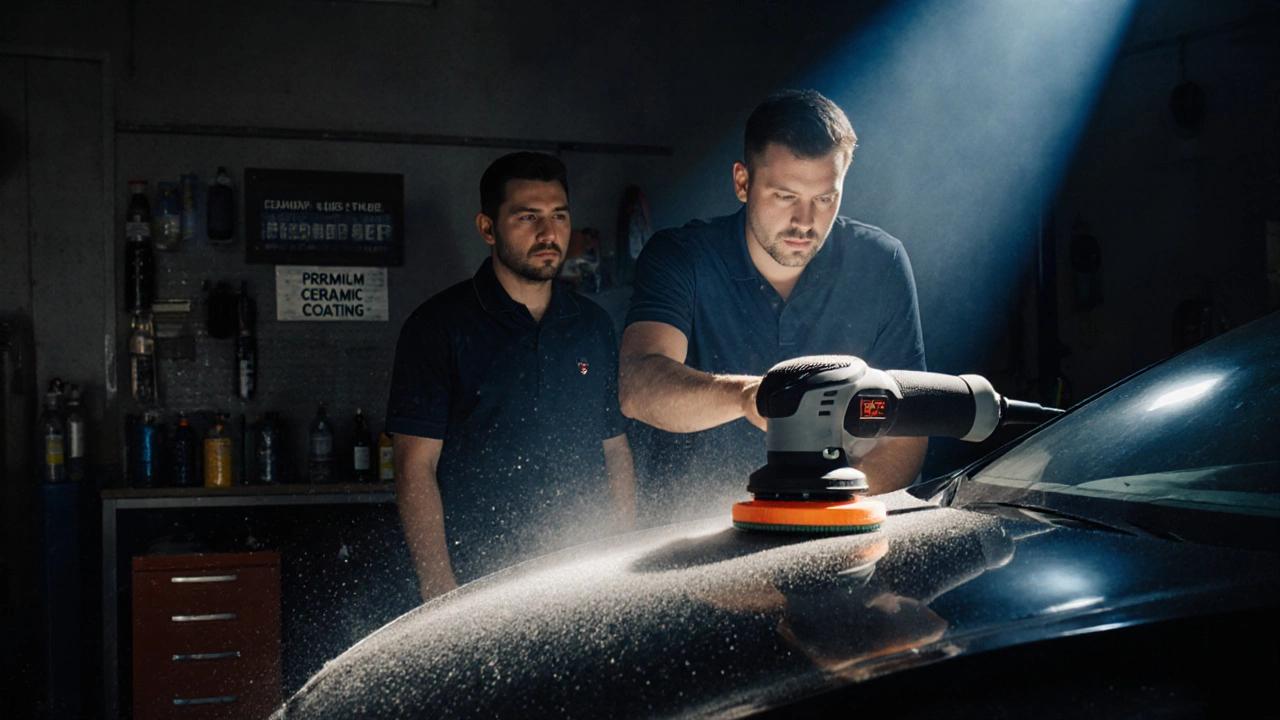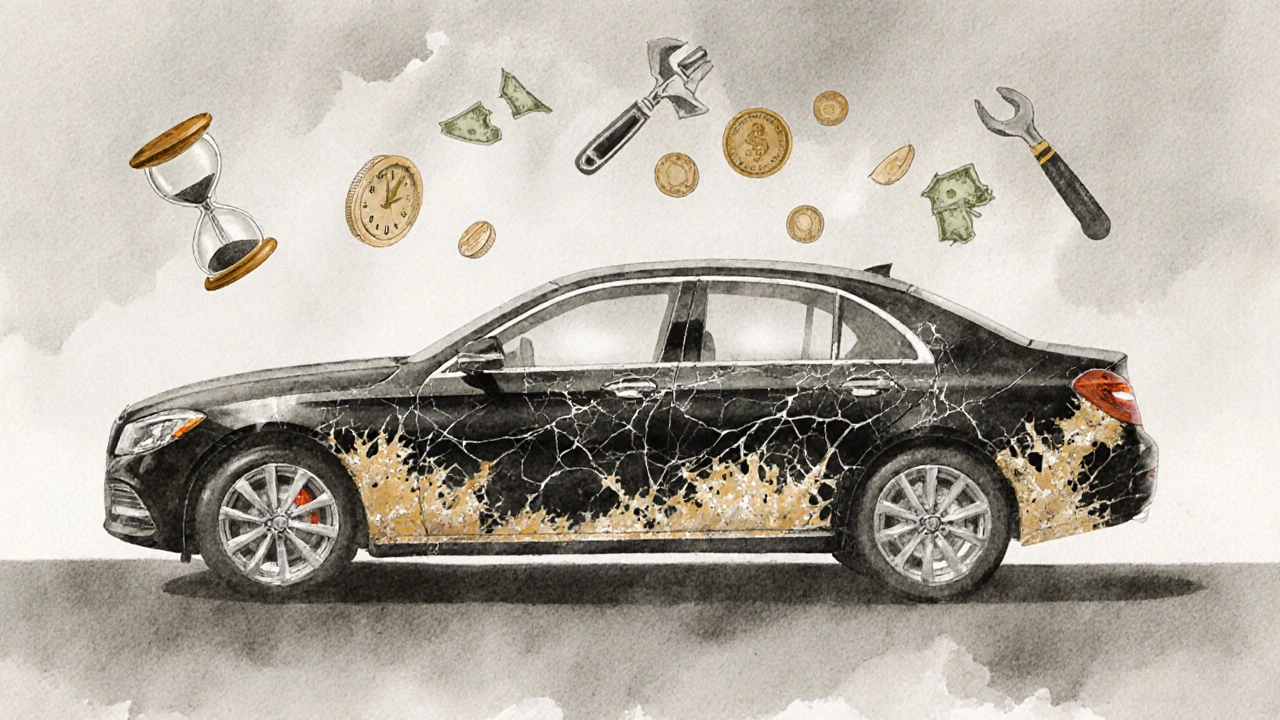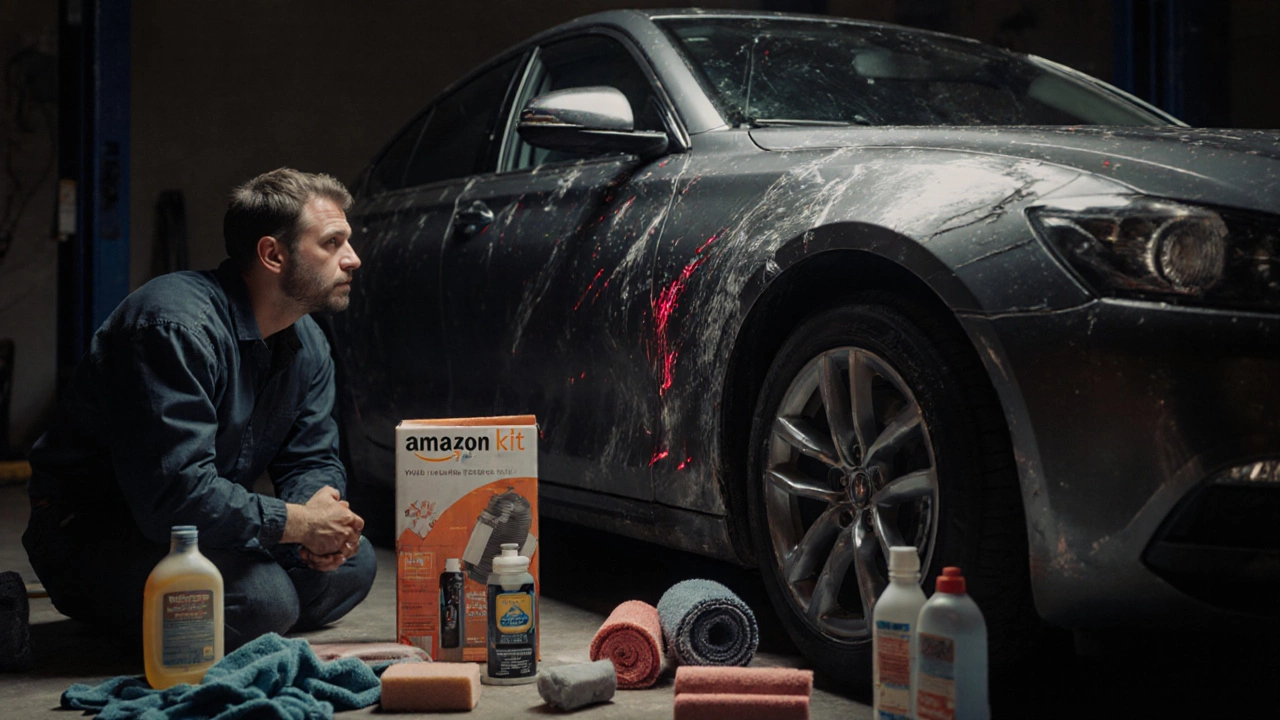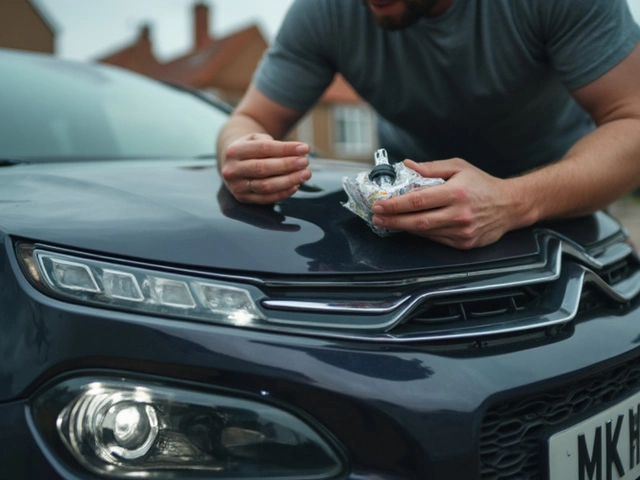Car Detailing Cost Calculator
Your Detailing Plan
Basic Maintenance Comparison
Standard wash
$25
Quarterly sealant
$50
Total annual cost
$225
Estimated paint protection
6-12 months
Your Annual Cost Summary
Car detailing makes your vehicle look showroom-new. But here’s the truth most ads won’t tell you: it’s not all shine and satisfaction. For every glossy finish, there’s a hidden cost, a risky step, or a mistake that can cost you hundreds-or worse, ruin your paint. If you’re thinking about detailing your car, whether you’re doing it yourself or hiring a pro, you need to know what you’re getting into.
It’s Not Just Time-It’s Money
Most people think car detailing is a one-time thing. It’s not. A full detail, done right, can cost between $200 and $600. If you’re doing it yourself, you’re not just buying a kit-you’re buying clay bars, dual-action polishers, microfiber towels, sealants, waxes, and specialized cleaners. A decent starter kit runs $150 alone. And if you mess up? You might need to buy more. And then more. And then maybe a professional to fix your mistake.
And that’s just the start. If you detail your car every 3 months-which is what experts recommend to keep protection intact-that’s $800 to $2,400 a year. Compare that to a good quality car wash that costs $25. You’re spending 30 to 90 times more just to keep it clean. For most drivers, that’s not practical. It’s luxury, not necessity.
Paint Damage Is Real-And Common
One wrong move with a clay bar, a cheap polish, or a dirty microfiber towel, and you can scratch your paint. It doesn’t take much. A single grain of sand trapped in a towel can leave swirl marks that are impossible to remove without machine polishing. And if you don’t know how to use a buffer correctly? You can burn through your clear coat.
There are hundreds of videos online showing people ruining their paint in under 10 minutes. One guy used a $30 kit from Amazon to “revive” his black Tesla. He ended up with hazing, swirls, and a $1,200 paint correction job. That’s not an outlier. It’s the norm for beginners. Even pros make mistakes. A study by the International Detailing Association found that 37% of paint damage claims from detailing services came from over-polishing or using incorrect pads.
Professional Detailers Aren’t Always Experts
Anyone can hang out a shingle and call themselves a detailer. There’s no license, no certification required in most states. You might walk into a shop with glowing reviews, only to find the guy using a $50 orbital buffer and a sponge he bought at Walmart. He might charge you $400 for a “premium” detail, but if he doesn’t know the difference between a finishing polish and a compound, you’re paying for hype, not results.
And don’t assume “ceramic coating” means quality. Many shops slap on a cheap spray-on coating that lasts 3 months-not 2 years like they promise. The real stuff? It’s applied in a dust-free room, with multiple layers, and cured under UV lights. Most shops don’t have that setup. They’re just spraying on gloss enhancers and calling it ceramic.
It Doesn’t Fix Real Problems
Detailing hides flaws. It doesn’t fix them. If your paint has chips, deep scratches, or oxidation, no amount of wax will make them disappear. You might walk away with a shiny car that looks great in sunlight-but under a garage light, the damage is still there. Worse, the wax or sealant can make those flaws more obvious by reflecting light unevenly.
Same goes for interior detailing. You can clean your leather seats, but if they’re cracked from sun exposure, a conditioner won’t repair them. You’re just masking the decay. And if you use the wrong cleaner on plastic trim, you’ll make it brittle and turn it white. That’s not restoration. That’s damage.

Time and Effort Are Often Wasted
Doing a full detail yourself takes 6 to 12 hours. That’s a full weekend. You’ll spend hours washing, clay barring, polishing, sealing, vacuuming, wiping down trim, cleaning windows, and then waiting for products to cure. For most people, that’s not relaxing. It’s exhausting. And if you’re not passionate about it, you’ll skip steps. You’ll rush the drying. You’ll reuse a towel. You’ll cut corners.
And then you’ll wonder why your car doesn’t look as good as the ones on Instagram. Spoiler: those aren’t real. They’re staged. The lighting is perfect. The angle is perfect. The car was washed right before the photo. You’re comparing your 8-hour effort to a 2-hour photoshoot.
Over-Detailing Can Hurt Your Car
More isn’t better. Washing your car every week? Fine. Detailing it every month? Maybe. Doing a full polish every 6 weeks? That’s dangerous. Each polish removes a tiny layer of clear coat. Over time, that adds up. A typical clear coat is only 1.5 to 2 mils thick. After 5 aggressive polishes, you’re risking exposure to the base paint.
And what about wax? Applying it every month? You’re building up layers that become cloudy and hard to remove. The same goes for sealants. Too many layers trap dirt, create uneven gloss, and make future corrections harder. Detailing should protect. Too much of it does the opposite.
It Doesn’t Protect Against Real-World Damage
Detailing gives you a shiny surface. It doesn’t give you armor. A rock chip from the highway? A bird dropping left on your hood for 3 days? A parking lot ding? No wax, sealant, or ceramic coating will stop that. You might think you’re protecting your car, but you’re just making it look nice until the next real-world hit.
For actual protection, you need paint protection film (PPF) or a quality wrap. Those cost $2,000 to $5,000-but they last 5 to 10 years. Detailing lasts 3 to 6 months. That’s not protection. That’s decoration.

Emotional Payoff vs. Practical Value
There’s no denying the feeling of driving a clean, shiny car. It feels good. But is it worth the cost, time, and risk? For a daily driver with 100,000 miles? Probably not. For a classic car you’re restoring? Maybe. For a brand-new luxury vehicle you plan to keep for 10 years? That’s a different story.
Most people detail because they want to impress. But no one notices the polish on your hood. They notice if your tires are bald, your brakes are squealing, or your headlights are foggy. Those are the things that matter. Detailing is the cherry on top-not the foundation.
When Detailing Makes Sense
It’s not all bad. Detailing has value-if you’re smart about it. If you have a car you care about, and you’re willing to learn the right way, then a biannual deep clean with proper products can help preserve your paint and interior. But skip the monthly wax. Skip the aggressive polishing. Skip the YouTube tutorials that promise miracles in 10 minutes.
Instead, focus on: washing with a two-bucket method, using a quality microfiber towel, applying a sealant once a year, and letting professionals handle paint correction. That’s it. You’ll save money, avoid damage, and still have a car that looks great.
Bottom Line
Car detailing isn’t a scam. But it’s not magic either. It’s a high-risk, high-cost hobby that only pays off if you know exactly what you’re doing. Most people end up spending more, doing more harm than good, and feeling disappointed. If you’re not ready to invest the time, money, and learning curve-skip it. A good wash and a coat of spray wax every few months will keep your car looking better than 90% of the cars on the road. And you won’t risk your paint.
Is car detailing worth the cost?
It depends on your goals. If you want to protect your car’s value over the long term and you’re willing to learn proper techniques, yes. But for most people, the cost and risk outweigh the benefits. A regular wash and yearly sealant cost less than $100 and do more good than a monthly $400 detail.
Can I damage my car’s paint by detailing it myself?
Absolutely. Using dirty towels, cheap products, or a buffer incorrectly can cause swirl marks, holograms, or even burn through the clear coat. Over 35% of paint damage from DIY detailing comes from improper polishing or using the wrong tools. If you’re new, start with hand washing and avoid machine polishing until you’ve trained properly.
How often should I detail my car?
For most drivers, a full detail every 6 to 12 months is enough. Between those, stick to regular washing (every 2 weeks) and a quick spray sealant every 3 months. Weekly detailing or polishing is unnecessary and harmful. It wears down your paint faster than road grime ever could.
Are professional detailers always better than DIY?
No. Many shops cut corners. They use low-quality products, skip prep steps, and overpromise results. Always ask what products they use, whether they have a dust-free bay, and if they offer a warranty. A reputable pro will show you their work process. If they can’t, find someone else-or do it yourself with the right knowledge.
Does ceramic coating eliminate the need for detailing?
No. Ceramic coatings protect paint but don’t clean it. You still need to wash your car regularly. Dirt, bird droppings, and tree sap can still damage the surface if left too long. A ceramic coating makes cleaning easier and adds durability, but it doesn’t replace maintenance. Think of it as armor-not a magic shield.






